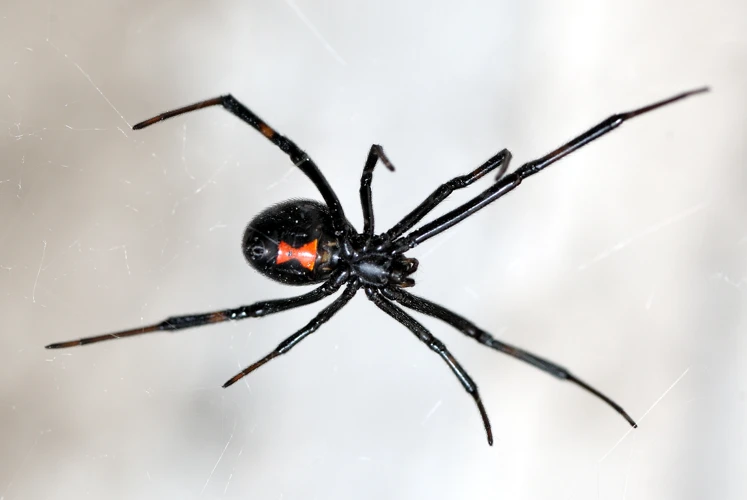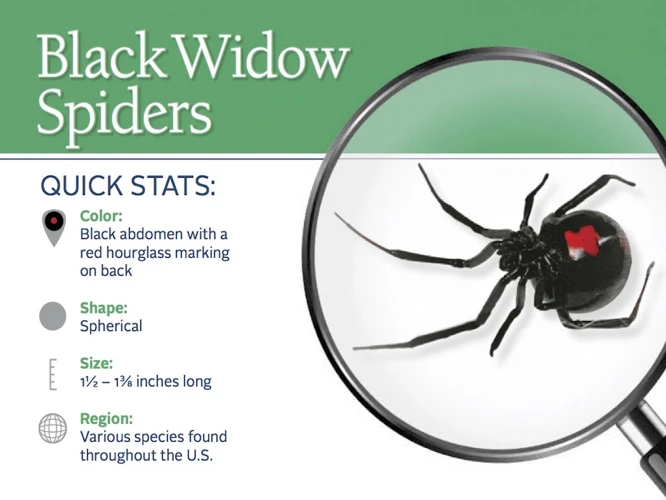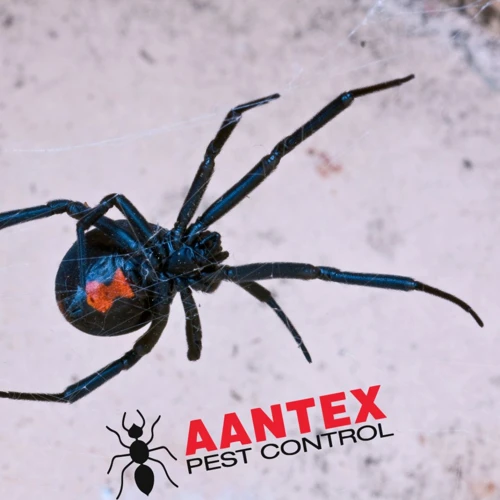As we spend more time outdoors, the likelihood of encountering pests like black widow spiders grows. These venomous arachnids can be a real danger to anyone who gets too close, and their bites can be incredibly painful. That’s why it’s important to keep them out of your home. In this article, we’ll explore how to seal outdoor cracks and gaps to prevent black widow spiders from entering your home. From inspecting your home for gaps and cracks to preventing spiders through yard management, we’ll provide step-by-step instructions to keep your family safe and spider-free. Let’s get started.
Why seal your home from black widow spiders?

When it comes to protecting your home and loved ones, taking preventive measures against potential threats should always be a top priority. One of the dangers that homeowners should be aware of and take action against are black widow spiders. These venomous arachnids can pose serious health risks to humans, especially children and the elderly. In this section, we will explore the importance of sealing your home from black widow spiders, and how doing so can help prevent these pests from entering your living space. By sealing gaps and cracks in your home and practicing proper yard management, you can significantly reduce the risk of black widow spider infestations.
Dangers of black widow spider bites
Black widow spider bites can pose serious health risks to humans. Their bites contain a powerful neurotoxin that can cause severe muscle pain, cramps, spasms, abdominal pain, and difficulty breathing. In some cases, bites can even lead to hospitalization and potentially life-threatening complications.
To minimize the risk of black widow spider bites, it’s crucial to seal any cracks and gaps where they may enter your home. These include cracks in walls, gaps around windows and doors, openings around pipes and electrical outlets, and much more. Neglecting these small but crucial areas can lead to a serious infestation.
But that’s not all! Black widow spiders are also attracted to clutter and debris around your yard. This makes it essential to clear out debris and maintain your yard regularly. Additionally, keeping vegetation trimmed and tidy can also help keep these dangerous spiders at bay.
While sealing your home and maintaining your yard can be done individually, it’s best to leave the work to professionals when dealing with a severe infestation. Remember, black widow spiders are dangerous, and their bites can be lethal.
Don’t risk your health and safety for the sake of convenience. Take the necessary steps to prevent these spiders from entering your home and yard.
For more information on how to seal your home from black widow spiders, check out our article on sealing outdoor cracks and gaps.
Find and seal gaps and cracks

Ensuring that your home is properly sealed is crucial when it comes to preventing black widow spiders from venturing inside. There are a variety of gaps and cracks around your home that can provide easy access for these venomous arachnids, which is why it’s important to identify and seal them off. In this section, we’ll explore some effective methods for identifying potential entry points and sealing gaps and cracks using common household materials such as caulk and screen mesh. By taking the time to properly seal your home, you can significantly reduce the risk of a black widow spider infestation.
Inspecting your home
It is essential to inspect your home thoroughly to identify any gaps or cracks where black widow spiders can enter. Taking this step is crucial in preventing these venomous spiders from entering your home and posing a risk to your family’s safety. Here are some crucial points to consider when inspecting your home:
- Windows and Doors: Check all the windows and doors in your home for gaps and cracks. Using weather stripping and caulking, seal any openings that could potentially provide the entry of black widow spiders.
- Foundation: Inspect the foundation of your home for cracks. Black widow spiders can enter through even the smallest cracks. Seal any cracks found with caulk or use a professional to repair the foundation crack.
- Electrical Outlets: Electrical outlets also require inspection when sealing gaps to prevent black widow spiders. Use outlet sealers or install child safety plugs to seal outlets since they are known entry points for black widow spiders. If you want to know more about how to seal electrical outlets to prevent spiders, check out this detailed guide.
- Pipes: Pipes are also an entry point for these venomous spiders. Seal pipe gaps with caulking to prevent spiders from entering your homes. If you want to know more about how to seal pipe gaps to prevent black widow spiders, check out this detailed guide.
- Attic: Check for cracks and gaps in the attic, especially near the roofline. You can use mesh screens or caulk to seal these openings. For more information on how to seal attic cracks, read our article on sealing attic cracks.
- Siding: Check for any cracks in your siding and seal them using caulk or foam. If you want to know more about how to prevent black widows from entering your home through cracks in your siding, check out this article on preventing black widows from cracks in your siding.
- Air Sealing: Air sealing your home is a great way to prevent black widows and other pests from entering your home. Check for air leaks near doors, windows, and other openings. You can use weather stripping and caulk to seal these gaps. For more information on how to air seal your home, check out our article on air sealing your home.
By following these steps and sealing any cracks and gaps in your home, you can effectively prevent black widow spiders from entering your home. For more information on why sealing cracks is important for black widow spider prevention, check out our article on why sealing cracks is essential for black widow spider prevention.
Sealing gaps and cracks with caulk
When it comes to sealing gaps and cracks to prevent black widow spiders from entering the home, using caulk is a highly effective method. This is because it provides a long-lasting, waterproof seal that can withstand the elements and keep black widows at bay. Here are the steps you can take to seal gaps and cracks with caulk:
Step 1: Inspect your home
Before you begin sealing gaps and cracks with caulk, it’s important to thoroughly inspect your home to identify any areas where black widows may be entering. This can include gaps around windows and doors, as well as holes in the walls or foundation. For more information on inspecting your home for gaps and cracks, you can refer to our guide on sealing gaps around windows and doors to keep black widows out.
Step 2: Choose the right type of caulk
When it comes to sealing gaps and cracks with caulk, it’s important to choose the right type of caulk for the job. Silicone or latex caulk are both excellent choices, as they are waterproof and flexible enough to seal small gaps and cracks. Before applying caulk, be sure to clean the area thoroughly with a wire brush to remove any loose debris and dirt.
Step 3: Apply the caulk
Once you have the right type of caulk and have cleaned the area, it’s time to apply the caulk. Begin by cutting the tip of the caulk tube at a 45-degree angle, then apply a steady and consistent bead of caulk along the gap or crack. Use a caulk smoothing tool or your finger to smooth out the caulk and ensure it adheres properly.
Step 4: Let the caulk dry
After you’ve applied the caulk, it’s important to let it dry completely before painting or exposing it to water. This can take anywhere from 24 to 48 hours, depending on the type of caulk you’ve used and the weather conditions in your area.
Step 5: Inspect and touch up as needed
Finally, after the caulk has dried completely, it’s a good idea to inspect your work and touch up any areas that may still have gaps or cracks. For larger gaps or cracks, you may want to consider using screen mesh or expanding foam to provide an additional barrier against black widows. For more information on sealing cracks in your home’s foundation, check out our guide on preventing black widow spiders through foundation cracks.
Sealing gaps and cracks with caulk is a highly effective way to prevent black widows from entering the home. However, it’s important to remember that this is just one piece of the puzzle when it comes to spider control. For more tips and tricks on keeping black widows (and other spiders) at bay, be sure to check out our guide on sealing up gaps and cracks to keep black widows out.
Sealing gaps and cracks with screen mesh
One effective way to seal gaps and cracks is by using screen mesh. This is particularly useful for larger openings where caulk may not be sufficient. Here are the steps to seal gaps and cracks with screen mesh:
- Step 1: Choose the right type of screen mesh. Look for a durable, rust-resistant material that can withstand exposure to the elements. Fiberglass or metal screens are good options.
- Step 2: Measure the gap or crack you need to seal. Cut a piece of screen mesh that is slightly larger than the opening.
- Step 3: Secure the screen mesh over the gap or crack using staples or adhesive. Make sure the screen is pulled tightly so there are no gaps or spaces where spiders could enter.
- Step 4: If necessary, use a utility knife to trim any excess screen mesh.
Screen mesh is a great option for sealing gaps and cracks because it not only keeps out spiders, but it also allows airflow and light to pass through. This is especially important for areas like vents or windows, where proper ventilation is necessary. Remember to regularly inspect and replace the screen mesh as needed, particularly if it becomes damaged or worn over time. With these simple steps, sealing gaps and cracks with screen mesh can be an effective way to prevent black widow spiders from entering your home.
Preventing black widow spiders through yard management

Protecting your home from black widow spiders doesn’t just involve sealing gaps and cracks indoors. Your yard can also play a significant role in controlling these venomous arachnids. Yard management is an effective way to reduce the likelihood of black widow spiders infesting your home. By making a few simple changes to the environment around your house, you can minimize the presence of black widows and keep your family safe. In this section, we will discuss some practical tips for spider-proofing your yard.
Clearing debris
Clearing debris from your yard is an essential step in preventing black widow spiders from entering your home. Black widows often build their webs in piles of debris, including fallen leaves, logs, old furniture, and other yard waste. By removing these potential habitats, you can significantly reduce the number of black widow spiders around your home.
The following table provides a list of common debris that can attract black widow spiders, as well as tips for removing it from your yard:
| Debris | Removal Tips |
|---|---|
| Leaves | Rake them up and place them in yard waste bags for disposal. |
| Grass clippings | Bag them up and dispose of them in the trash. |
| Tree branches | Cut them up and place them in yard waste bags for disposal. |
| Old furniture | Donate it to a local charity or dispose of it at a proper waste facility. |
| Empty containers | Recycle them if possible or dispose of them in the trash. |
It’s important to note that clearing debris is not a one-time event. You should regularly inspect your yard for new debris and promptly remove it to keep black widows at bay. By preventing black widow spiders from creating a habitat around your home, you can reduce the risk of encountering these dangerous spiders and protect your family from their potentially harmful bites.
Maintaining vegetation
Maintaining vegetation around your home can be an effective way to prevent black widow spiders from entering your living space. Here are some tips for ensuring that your yard is not an attractive habitat for these venomous arachnids.
Tip #1: Keep the grass short. Tall grass can provide a cozy hiding space for black widows. To avoid this risk, mow your grass regularly.
Tip #2: Trim bushes and shrubs. Just like tall grass, unkempt bushes and shrubs can be perfect hideouts for black widows. Regular pruning and trimming will remove the potential living space for spiders.
Tip #3: Remove debris regularly. Dead leaves, branches, and logs can accumulate in your yard and become a prime location for black widows and other insects to call home. Be sure to regularly remove these items and dispose of them properly to avoid attracting spiders.
Tip #4: Avoid overwatering your yard. Black widows thrive in moist environments, so be careful not to overwater your yard or garden, as this can create the perfect environment for them to thrive.
Tip #5: Consider planting repellant plants. Certain plants, such as lavender and peppermint, can help repel black widow spiders. Consider planting some of these plants around the perimeter of your home or garden.
By following these tips, you can make your yard less hospitable for black widow spiders and reduce the risk of them entering your home. Regular maintenance and upkeep will go a long way in keeping your living space spider-free.
| Tip # | Practice |
|---|---|
| 1 | Keep the grass short |
| 2 | Trim bushes and shrubs |
| 3 | Remove debris regularly |
| 4 | Avoid overwatering your yard |
| 5 | Consider planting repellant plants |
When to call a professional
Sometimes, no matter how vigilant and thorough you are in sealing and managing your yard, black widow spiders may still find a way into your home. In such cases, it may be necessary to call a professional pest control service.
Here are some signs that it’s time to call a professional:
- You have a severe infestation: If you are observing a large number of black widow spiders inside your home or yard, it’s a clear indication of a severe infestation. Professional pest control services have access to comprehensive and effective treatments to get rid of the spiders and prevent them from coming back.
- You are finding egg sacs: If you come across a black widow egg sac, it’s a sign that there are many more spiders around. Unfortunately, these spiders reproduce rapidly, which means the problem will only escalate without immediate intervention. Calling a pest control professional to take care of the egg sacs and the spiders is recommended.
- You or someone in your home has been bitten: Black widow spider bites can be very dangerous, especially for young children and the elderly. If someone in your home is bitten by a black widow spider, it’s important to seek medical attention immediately. It’s necessary to call a pest control professional to eradicate the spiders from your home.
In conclusion, while it’s possible to manage and prevent black widow spiders from entering your home, sometimes calling a professional pest control service is the best option. They have the knowledge and expertise to identify the severity of the infestation and utilize the most effective treatments to ensure the elimination of the spiders.
Conclusion
After taking the necessary steps to seal your home and maintain your yard, you can rest assured that you’re taking the precautionary measures needed to prevent black widow spiders from entering your home. These spiders prefer undisturbed areas, so keeping your environment clean and tidy can go a long way in safeguarding your home. Remember, black widow spiders are venomous and can cause serious harm if bitten, especially in vulnerable individuals such as young children, elderly individuals and individuals with weakened immune systems. By sealing gaps and cracks with caulk or screen mesh and managing your yard properly, you reduce your risk of black widow spider encounters and ultimately safeguard your family and loved ones. If you’re ever unsure about a potential infestation, it’s always better to be safe than sorry and consult with a pest control professional. By taking these steps and staying proactive, you can confidently enjoy your outdoor spaces and protect your home from unwanted visitors.
Frequently Asked Questions
What are black widow spiders?
Black widow spiders are venomous spiders native to North America. They are identified by their shiny black bodies and the red-hourglass shape on their abdomen.
How dangerous are black widow spiders?
Black widow spider bites can be very dangerous, especially for children, the elderly, and those with weakened immune systems. Symptoms can include severe pain, muscle cramps, and even paralysis.
How do I know if I have black widow spiders in my home?
Look for webbing in dark, secluded areas of your home, such as closet corners, garages, and basements. You may also see the spiders themselves, which are small, shiny black spiders with red markings.
Can I prevent black widow spiders from entering my home?
Yes, you can prevent black widow spiders from entering your home by sealing up any gaps or cracks in your home’s exterior. You can also manage your yard to reduce spider populations.
What is the best way to seal gaps and cracks in my home to keep out black widow spiders?
The best way to seal gaps and cracks in your home is with a high-quality silicone caulk. You can also use screen mesh to cover larger gaps.
What should I look for when inspecting my home for gaps and cracks?
Look for gaps around windows and doors, as well as where pipes and wires enter your home. You should also inspect the foundation, roof, and attic for any gaps or cracks.
How often should I clear debris from my yard to prevent black widow spiders?
You should clear debris from your yard at least once a year, preferably in the fall. This will help to reduce spider populations and prevent them from entering your home.
What types of vegetation should I avoid planting in my yard to prevent black widow spiders?
Avoid planting dense, shrubby plants and groundcover, as these can provide ideal hiding spots for spiders. Stick with low-maintenance, open plantings instead.
What should I do if I suspect I have a black widow spider infestation?
If you suspect you have a black widow spider infestation, you should contact a professional exterminator. Trying to handle the infestation on your own can be very dangerous.
Can I use insecticides to prevent black widow spiders?
While insecticides can help to reduce spider populations, they are not always effective at preventing black widow spiders. It is best to focus on sealing your home and managing your yard to prevent spiders from entering.






